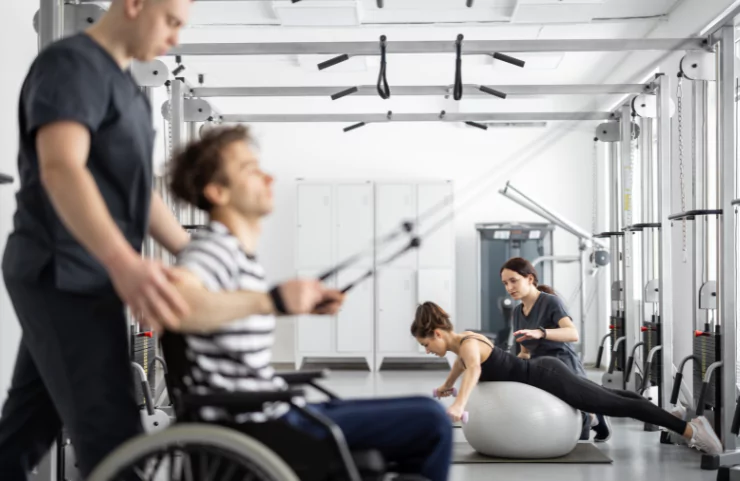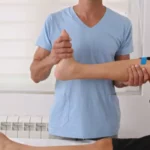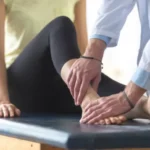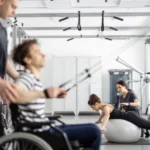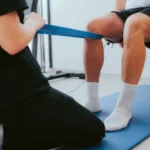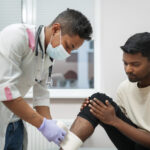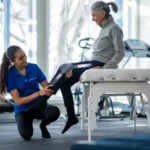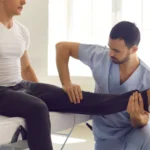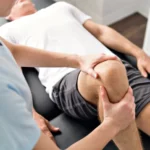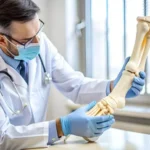Physiotherapy For Gym Injuries In Thane
Introduction
In Thane, we see a growing wave of fitness enthusiasts, people who are committed to staying active, building strength, and pushing their limits. It’s inspiring. But with this rise in gym culture comes a parallel increase in injuries. At our clinic, we’ve treated hundreds of patients who walked in frustrated, confused, and in pain after a workout gone wrong. These aren’t just isolated incidents. They’re part of a larger pattern we’ve observed over the years. Whether it’s a shoulder strain from overhead presses or a nagging knee pain from squats, gym injuries can derail progress and dampen motivation. That’s where physiotherapy steps in—not just to treat, but to rebuild. Our approach blends orthopedic insight with targeted rehabilitation, helping patients recover faster and smarter. We believe that healing isn’t just about rest, it’s about movement, awareness, and guided care.
What Causes Gym Injuries?
Gym injuries rarely happen in isolation. They’re often the result of accumulated stress, poor form, or overlooked warning signs. One of the most common culprits is overtraining, pushing the body beyond its recovery capacity. We’ve seen patients who train six days a week without adequate rest, leading to microtrauma that eventually flares up. Another major factor is biomechanics. Muscle imbalances, tight joints, and poor posture can distort movement patterns, making certain exercises risky. Technique matters too. A deadlift with a rounded back or a squat with collapsed knees can strain the spine and joints. Even the gym environment plays a role, slippery floors, worn-out shoes, or poorly adjusted equipment can trigger accidents. And let’s not forget fatigue. When the body is tired, coordination drops, and that’s when injuries sneak in. Understanding these causes helps us tailor physiotherapy plans that don’t just treat pain, they prevent it from coming back.
Common Gym Injuries We Treat in Thane
Over the years, we’ve seen a consistent set of injuries among gym-goers in Thane. Shoulder impingement tops the list, especially among those who lift heavy or perform repetitive overhead movements. The rotator cuff, a group of stabilizing muscles, often gets strained when form breaks down. Lower back pain is another frequent complaint, usually linked to deadlifts, squats, or poor posture during core workouts. Knee issues, particularly patellofemoral pain, arise from lunges, running, or improper alignment during squats. Elbow and wrist injuries, like tennis elbow or carpal tunnel symptoms, are common in grip-intensive routines. And then there are shin splints, often seen in treadmill runners or those who suddenly ramp up cardio. Each of these injuries has a unique recovery path, and physiotherapy plays a central role in restoring function, reducing pain, and guiding safe return to training.
Why Physiotherapy Is More Than Just Rehab
Physiotherapy isn’t a passive process. It’s not just about lying on a table and getting a massage. It’s an active, science-driven approach to healing. At our clinic, we use physiotherapy to retrain muscles, restore joint mobility, and correct movement patterns. When someone walks in with a gym injury, we don’t just treat the pain, we investigate the root cause. Was it poor form? Muscle imbalance? Lack of flexibility? Our sessions involve targeted exercises, manual therapy, and neuromuscular re-education. We also teach patients how to move better, lift smarter, and recover fully. The goal isn’t just to get back to the gym, it’s to stay there without recurring injuries. Physiotherapy empowers patients to understand their bodies, respect their limits, and build resilience. It’s not a luxury, it’s essential.
Our Integrated Care Model
What sets our clinic apart is the seamless integration of orthopedic expertise with in-house physiotherapy. When a patient walks in with a gym injury, they’re first evaluated by our orthopedic team. We assess joint integrity, rule out serious damage, and identify biomechanical faults. Then, our physiotherapists step in with a customized recovery plan. This includes functional movement screening, targeted exercises, and manual therapy. We track progress closely, adjusting protocols as needed. Our return-to-gym plans are gradual and safe, ensuring that patients don’t rush back and risk re-injury. This collaborative model allows us to treat the whole person, not just the injury. It’s efficient, effective, and deeply personalized. Patients appreciate the continuity of care, and we see better outcomes because of it.
Tools and Techniques We Use
Our clinic in Thane is equipped with modern, evidence-based physiotherapy tools. We use dry needling to release deep muscle knots and trigger points. Shockwave therapy helps accelerate tendon healing, especially in chronic cases. Kinesio taping provides joint support and improves proprioception during movement. Resistance band protocols allow safe strengthening without overloading joints. We also use smart sensors for gait and posture analysis, helping us identify subtle faults that might lead to injury. Manual therapy, mobilizations, manipulations, and soft tissue work, is a cornerstone of our practice. These tools aren’t just fancy add-ons. They’re part of a strategic plan to restore movement, reduce pain, and build long-term resilience. Every technique is chosen based on the patient’s needs, goals, and recovery timeline.
Thane’s Fitness Culture
Thane is evolving. We’re seeing more gyms, bootcamps, yoga studios, and fitness influencers than ever before. It’s exciting, but it also comes with risks. As more people embrace fitness, we’re seeing a rise in injuries due to poor guidance, rushed workouts, and lack of recovery. That’s why clinics like ours are stepping up. We collaborate with local gyms, trainers, and wellness centers to promote safe training practices. We offer workshops on injury prevention, posture correction, and recovery strategies. Our goal is to support Thane’s fitness culture, not just with treatment, but with education. We want people to train smarter, recover faster, and stay active for life. Fitness should be empowering, not painful. And with the right support, it can be.
Prevention Tips From Our Team
Prevention is always better than cure. At our clinic, we emphasize proactive care. Start every workout with a dynamic warm-up, mobilize joints, activate muscles, and prepare the body. Focus on form over weight. Lifting heavier isn’t impressive if it leads to injury. Rest days are essential. They allow the body to repair and grow stronger. Use proper footwear and train on stable surfaces. Listen to pain, it’s a signal, not a nuisance. If something feels off, stop and reassess. Hydration, sleep, and nutrition also play a role in recovery. And don’t hesitate to seek guidance. A quick physiotherapy check-up can prevent months of rehab. We’re here to help, before, during, and after the workout.
Shoulder Injuries in Gym-Goers
Shoulder injuries are among the most common complaints we hear from gym enthusiasts in Thane. Whether it’s a rotator cuff strain from overhead presses or impingement from repetitive lifting, the shoulder joint is vulnerable to poor form and overuse. The complexity of the shoulder, being a ball-and-socket joint supported by multiple muscles and tendons, means that even minor imbalances can lead to significant pain and dysfunction. Physiotherapy plays a vital role in restoring shoulder mobility, strength, and stability. We often begin with gentle mobilizations and progress to resistance-based exercises that retrain the rotator cuff and scapular muscles. For those looking to understand the kinds of exercises that support shoulder recovery, we recommend this excellent guide on shoulder pain rehab exercises. It covers everything from warm-ups to band rotations and is a great resource for patients and trainers alike.
Game-Changer in Sports Injury Recovery
Dry needling has become one of our go-to techniques for treating deep muscle tension and trigger points in gym-related injuries. Unlike acupuncture, dry needling targets myofascial knots directly, using thin needles to release muscle tightness and improve circulation. It’s especially effective for chronic pain, post-workout soreness, and recovery plateaus. We’ve used it successfully for conditions like tennis elbow, jumper’s knee, and rotator cuff dysfunction. The technique works by stimulating a local twitch response, which helps reset muscle tone and relieve stress on joints. For a deeper dive into how dry needling fits into modern sports rehab, we recommend reading this article on dry needling in sports recovery. It explains the science behind the technique and why it’s gaining popularity among physiotherapists and athletic trainers.
Functional Movement Screening
One of the most powerful tools we use in our clinic is the Functional Movement Screen (FMS). It’s a simple yet effective way to identify movement asymmetries, joint instability, and muscular imbalances before they lead to injury. The FMS involves seven key movement patterns, from squats to lunges to shoulder mobility tests, and helps us pinpoint areas that need corrective work. For gym-goers, this screening is invaluable. It allows us to customize physiotherapy plans that not only treat current issues but also prevent future ones. If a patient scores low on the FMS, we know they’re at higher risk for injury and can intervene early. To learn more about how FMS works and why it’s used in physical therapy, check out this overview from Physiopedia. It breaks down the methodology and its application across athletic and general populations.
The Foundation of Injury Prevention
When we talk about injury prevention, core stability often gets overlooked. Many gym-goers focus on visible muscles, biceps, quads, shoulders, but forget that the core is what holds everything together. A strong core isn’t just about six-pack abs. It’s about deep stabilizing muscles that support the spine, pelvis, and hips during movement. We’ve seen countless cases where poor core engagement led to lower back pain, hip strain, or even knee issues. In physiotherapy, we prioritize core activation early in the recovery process. Simple exercises like dead bugs, bird dogs, and planks, when done with proper technique, can dramatically improve posture and reduce injury risk. Core stability also enhances balance, coordination, and lifting mechanics. It’s the silent hero of safe training, and we make sure every patient understands its role in long-term fitness.
How We Guide Safe Comebacks
One of the most common questions we get is: “When can I go back to the gym?” The answer isn’t one-size-fits-all. Recovery depends on the type of injury, the patient’s baseline fitness, and how well they respond to physiotherapy. That’s why we’ve developed structured return-to-gym protocols. These aren’t just timelines, they’re progressive plans that rebuild strength, mobility, and confidence. We start with low-impact movements, assess tolerance, and gradually reintroduce gym-specific exercises. For example, someone recovering from a shoulder strain might begin with band work before returning to overhead presses. We also educate patients on pacing, rest intervals, and post-workout recovery. Our goal is to prevent re-injury and ensure that every comeback is sustainable. Fitness is a journey, and we’re here to guide every step.
Healing Beyond Muscles and Joints
Recovery isn’t just physical, it’s psychological. Pain, especially when persistent, can affect mood, motivation, and self-image. We’ve seen patients who felt defeated after an injury, worried they’d never train again. That’s why we emphasize the mind-body connection in our physiotherapy sessions. Breathing techniques, mindfulness, and movement awareness are part of our approach. When patients learn to tune into their bodies, they move with more control and less fear. This awareness reduces compensatory patterns and improves healing outcomes. We also encourage goal-setting and celebrate small wins, like walking pain-free or lifting without discomfort. These moments rebuild confidence and remind patients that recovery is possible. At our clinic, healing is holistic. We treat the body, support the mind, and restore the spirit of movement.
FAQs
Q.1: What gym injuries do we treat most often?
Ans. Shoulder strains, lower back pain, knee issues, and grip-related elbow injuries are the most common.
Q.2: Is early physiotherapy better than waiting?
Ans. Absolutely. Early care reduces pain, speeds recovery, and prevents recurrence.
Q.3: Do we work with gyms and trainers in Thane?
Ans. Yes. We collaborate to ensure safe, informed training during and after rehab.
Q.4: How can someone book a consultation?
Ans. Call us at +91 99670 63812 or visit acktivortho.com.
Conclusion
Gym injuries can feel like setbacks, but they’re also opportunities to understand our bodies better, rebuild smarter, and come back stronger. At our clinic in Thane, we’ve seen firsthand how physiotherapy transforms frustration into progress. It’s not just about healing, it’s about learning, adapting, and growing. Whether someone is a seasoned lifter, a weekend runner, or just starting their fitness journey, our integrated orthopedic and physiotherapy care is designed to support every step.
Physiotherapy For Gym Injuries In Thane Physiotherapy For Gym Injuries In Thane Physiotherapy For Gym Injuries In Thane Physiotherapy For Gym Injuries In Thane Physiotherapy For Gym Injuries In Thane Physiotherapy For Gym Injuries In Thane Physiotherapy For Gym Injuries In Thane Physiotherapy For Gym Injuries In Thane Physiotherapy For Gym Injuries In Thane Physiotherapy For Gym Injuries In Thane Physiotherapy For Gym Injuries In Thane Physiotherapy For Gym Injuries In Thane Physiotherapy For Gym Injuries In Thane Physiotherapy For Gym Injuries In Thane Physiotherapy For Gym Injuries In Thane Physiotherapy For Gym Injuries In Thane Physiotherapy For Gym Injuries In Thane Physiotherapy For Gym Injuries In Thane Physiotherapy For Gym Injuries In Thane Physiotherapy For Gym Injuries In Thane Physiotherapy For Gym Injuries In Thane Physiotherapy For Gym Injuries In Thane Physiotherapy For Gym Injuries In Thane Physiotherapy For Gym Injuries In Thane Physiotherapy For Gym Injuries In Thane Physiotherapy For Gym Injuries In Thane Physiotherapy For Gym Injuries In Thane Physiotherapy For Gym Injuries In Thane Physiotherapy For Gym Injuries In Thane Physiotherapy For Gym Injuries In Thane Physiotherapy For Gym Injuries In Thane Physiotherapy For Gym Injuries In Thane Physiotherapy For Gym Injuries In Thane
